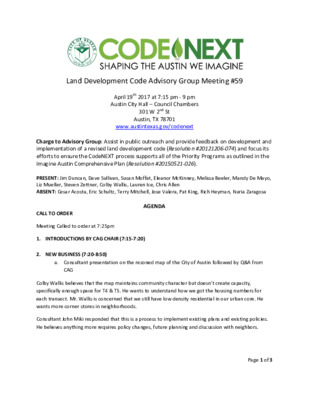Approved Minutes — original pdf
Approved Minutes

Page 1 of 3 Land Development Code Advisory Group Meeting #59 April 19th 2017 at 7:15 pm ‐ 9 pm Austin City Hall – Council Chambers 301 W 2nd St Austin, TX 78701 www.austintexas.gov/codenext Charge to Advisory Group: Assist in public outreach and provide feedback on development and implementation of a revised land development code (Resolution #20121206‐074) and focus its efforts to ensure the CodeNEXT process supports all of the Priority Programs as outlined in the Imagine Austin Comprehensive Plan (Resolution #20150521‐026). PRESENT: Jim Duncan, Dave Sullivan, Susan Moffat, Eleanor McKinney, Melissa Beeler, Mandy De Mayo, Liz Mueller, Steven Zettner, Colby Wallis, Lauren Ice, Chris Allen ABSENT: Cesar Acosta, Eric Schultz, Terry Mitchell, Jose Valera, Pat King, Rich Heyman, Nuria Zaragosa AGENDA CALL TO ORDER Meeting Called to order at 7:25pm 1. INTRODUCTIONS BY CAG CHAIR (7:15‐7:20) 2. NEW BUSINESS (7:20‐8:50) a. Consultant presentation on the rezoned map of the City of Austin followed by Q&A from CAG Colby Wallis believes that the map maintains community character but doesn’t create capacity, specifically enough space for T4 & T5. He wants to understand how we got the housing numbers for each transect. Mr. Wallis is concerned that we still have low density residential in our urban core. He wants more corner stores in neighborhoods. Consultant John Miki responded that this is a process to implement existing plans and existing policies. He believes anything more requires policy changes, future planning and discussion with neighbors. Page 2 of 3 Melissa Beeler wants to know why there are non‐transect zones in the urban core. John Miki said we will have more discussions. Jim Duncan added that the zones selected fit the current grid and land use patterns. Steve Zettner brought data on the disappearance of family friendly housing. John Miki explained that some of the zones were carried forward because of complicated CO’s. Mandy De Mayo brought up the 135K unit proposal by the mayor and asked whether the 140K proposed by this code and indicated by the ET software is aspirational. Chris Allen was concerned about the non‐transect zones in the urban core. He wants greater simplicity in the new code and believes that we are creating two separate codes. He also wanted to know if there is a way we can cope with fine grain differences of intensity. John Miki said the urban core may potentially be mapped transect, but there would have to be more zoning districts. Lauren Ice wants to know what other metrics are tracked through ET. Fregonese Consultant Alex Joyce said that we can provide the data that the CAG would like to see in Envision Tomorrow. Jim Duncan commented that what we are proposing today is two codes. Susan Moffat seconded Steven’s comments about family friendly homes. Susan likes the new formatting of transect and non‐transect zones. She doesn’t care about number of pages and would like parking in the form of both tables and paragraphs. She also wants to know why we aren’t building missing middle housing near major jobs centers and corridors that continue above and below the city center. John Miki responded that commercial use districts have been updated to include more options. Market Forces are at work; just entitling more units does not equal more units. He doesn’t want us to get too far ahead of the market without planning. Peter Park chimed in to say Market Readiness, but also applying the T‐Zones have more strict form standards so applying them further from the core, we would be creating non‐conforming uses. The buildings currently on the ground exceed the maximum setbacks. If there was a large planning effort or if a large property owner wanted to apply transect zones to make it nonconforming, we could do that over the next several months. In Denver it occurred with PUDs. But just because its not a T‐Zone, that doesn’t mean that missing middle cannot be provided. Dave Sullivan thinks that the count of the number of units is not enough. He is concerned that there is no T6. Eleanor McKinney wants to know what the aggregate increase of impervious cover is. She wants to know what TCAD may charge per square foot per zone so that people can learn how much they will be charged in property taxes from their new zone. She thinks we should also create other job centers besides downtown and the Domain. She thinks that substantive differences exist that need to be addressed between transect and use based zones such as landscape setbacks, open space, and parks, etc. Page 3 of 3 Jim Duncan ended the Q&A session by mentioning that we will have several months for intensive work. 3. FUTURE AGENDA ITEMS (8:50‐9:00) a. Upcoming Code TALK meetings (Affordability 5/8, Mobility 5/31, Permitting 6/7) b. District‐ based Mapping Meetings starting 4/22 c. B&C Comments to CAG deadline 5/15 d. Next CAG Meeting 5/24 ADJORNMENT The City of Austin is committed to compliance with the Americans with Disabilities Act. Reasonable modifications and equal access to communications will be provided upon request. Meeting locations are planned with wheelchair access. If requiring Sign Language Interpreters or alternative formats, please give at least 4 days notice before the meeting date. Please call Ashley Greenstein in the Planning and Zoning Department, at 512‐974‐2743, for additional information; TTY users route through Relay Texas at 711. For more information on the Code Advisory Group, please contact Ashley Greenstein in the Planning and Zoning Department at 512‐974‐2743 or Ashley.Greenstein@AustinTexas.gov.